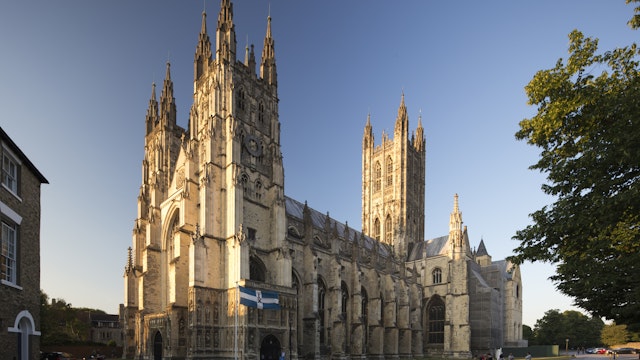A rich repository of more than 1400 years of Christian history, Canterbury Cathedral is the Church of England’s mother ship, and a truly extraordinary place with an absorbing history. This Gothic cathedral, the highlight of the city’s World Heritage Sites, is southeast England’s top tourist attraction as well as a place of worship. It is also the site of English history’s most famous murder: Archbishop Thomas Becket was killed here in 1170. The cathedral is an overwhelming edifice crammed with enthralling stories, arresting architecture and a very real and enduring sense of spirituality – although visitors can’t help but pick up on the ominous undertones of violence and bloodshed that whisper from its walls.
History
St Augustine, a missionary sent from Rome, built the first cathedral here sometime after his arrival in England in 597CE. He became the first Archbishop of Canterbury and formed a household here. A major fire damaged the building around 1070, leading to the cathedral being completely rebuilt by the Normans. Later, a community of Benedictine monks lived at the cathedral until Henry VIII's Dissolution of the Monasteries in 1540. Even after 800 years, it's the story of Archbishop Thomas Becket that continues to draw many pilgrims to Canterbury Cathedral.
The martyrdom of Thomas Becket
Not one to shy away from cronyism, in 1162 King Henry II appointed his good friend Thomas Becket to the highest clerical office in the land, figuring it would be easier to force the increasingly vocal religious lobby to fall into line if he was pals with the archbishop. Unfortunately for Henry, he underestimated how seriously Thomas would take the job, and the archbishop soon began to disagree with almost everything the king said or did.
By 1170, Henry had become exasperated with his former favorite and suggested to four of his knights that Thomas was too much to bear. Becket was murdered on December 29. Becket’s martyrdom – and canonization in double-quick time (1173) – catapulted Canterbury Cathedral to the top of the league of northern European pilgrimage sites. Mindful of the growing criticism of his role in Becket’s murder, Henry arrived in Canterbury in 1174 for a dramatic mea culpa and, after allowing himself to be whipped and scolded, was granted absolution.
Canterbury Cathedral today
This ancient structure is packed with monuments commemorating the nation’s battles. Also here are the grave and heraldic tunic of one of the nation’s most famous warmongers, Edward the Black Prince (1330–76). The spot in the northwest transept where Becket met his grisly end is marked by a flickering candle and a striking modern altar.
The doorway to the crypt is beside the altar. This cavernous space is the cathedral’s highlight, the only survivor from another devastating fire in 1174, which destroyed the rest of the building. Look for the amazingly well-preserved carvings among the forest of pillars.
The wealth of detail in the cathedral is immense and unrelenting, so allow at least two hours to do it justice.
Tickets
Entry to the cathedral is timed and tickets must be pre-booked online. Guided tours run with limited availability; call on the day (01227 762862) or ask at the desk on arrival.


